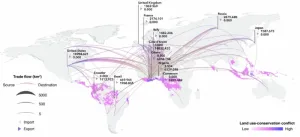(Press-News.org) Our familiar, warm, yellow sun is a relative rarity in the Milky Way. By far the most common stars are considerably smaller and cooler, sporting just half the mass of our sun at most. Billions of planets orbit these common dwarf stars in our galaxy.
To capture enough warmth to be habitable, these planets would need to huddle very close to their small stars, which leaves them susceptible to extreme tidal forces.
In a new analysis based on the latest telescope data, University of Florida astronomers have discovered that two-thirds of the planets around these ubiquitous small stars could be roasted by these tidal extremes, sterilizing them. But that leaves one-third of the planets – hundreds of millions across the galaxy – that could be in a goldilocks orbit close enough, and gentle enough, to hold onto liquid water and possibly harbor life.
UF astronomy professor Sarah Ballard and doctoral student Sheila Sagear published their findings the week of May 29 in the Proceedings of the National Academy of Sciences. Ballard and Sagear have long studied exoplanets, those worlds that orbit stars other than the sun.
“I think this result is really important for the next decade of exoplanet research, because eyes are shifting toward this population of stars,” Sagear said. “These stars are excellent targets to look for small planets in an orbit where it’s conceivable that water might be liquid and therefore the planet might be habitable.”
Sagear and Ballard measured the eccentricity of a sample of more than 150 planets around these M dwarf stars, which are about the size of Jupiter. The more oval shaped an orbit, the more eccentric it is. If a planet orbits close enough to its star, at about the distance that Mercury orbits the sun, an eccentric orbit can subject it to a process known as tidal heating. As the planet is stretched and deformed by changing gravitational forces on its irregular orbit, friction heats it up. At the extreme end, this could bake the planet, removing all chance for liquid water.
“It’s only for these small stars that the zone of habitability is close enough for these tidal forces to be relevant,” Ballard said.
Data came from NASA’s Kepler telescope, which captures information about exoplanets as they move in front of their host stars. To measure the planets’ orbits, Ballard and Sagear focused especially on how long the planets took to move across the face of the stars. Their study also relied on new data from the Gaia telescope, which measured the distance to billions of stars in the galaxy.
“The distance is really the key piece of information we were missing before that allows us to do this analysis now,” Sagear said.
Sagear and Ballard found that stars with multiple planets were the most likely to have the kind of circular orbits that allow them to retain liquid water. Stars with only one planet were the most likely to see tidal extremes that would sterilize the surface.
Since one-third of the planets in this small sample had gentle enough orbits to potentially host liquid water, that likely means that the Milky Way has hundreds of millions of promising targets to probe for signs of life outside our solar system.
END
One-third of galaxy’s most common planets could be in habitable zone
2023-05-29
ELSE PRESS RELEASES FROM THIS DATE:
Mapping the conflict between farming and biodiversity
2023-05-29
It’s well known that producing foods such as beef can have an outsized footprint when it comes to carbon emissions. But a new study shows that some of these same staples can have an equally huge effect when it comes to biodiversity losses.
One of the main problems, the study found, results when food production overlaps with areas that have been identified as having the highest conservation priority.
Food production remains the main cause of biodiversity loss.
“Food production remains the main cause of biodiversity loss,” said Keiichiro Kanemoto, an associate professor at the Research Institute for Humanity ...
COVID-19 vaccine builds powerful immune response in First Nations peoples, study finds
2023-05-29
Published in Nature Immunology and Nature Briefing, the research is the first of its kind to decisively map immune responses produced by a COVID-19 vaccination in any First Nations populations.
In partnership with Menzies School of Health Research, researchers at the Peter Doherty Institute for Infection and Immunity (Doherty Institute) evaluated immune responses in Aboriginal and Torres Strait Islander peoples and non-Indigenous individuals after receiving the mRNA COVID-19 vaccine.
Lead author of the study and PhD candidate at the Doherty ...
X-ray emissions from black hole jets vary unexpectedly, challenging leading model of particle acceleration
2023-05-29
Researchers discovered only relatively recently that black hole jets emit x-rays, and how the jets accelerate particles to this high-energy state is still a mystery. Surprising new findings in Nature Astronomy appear to rule out one leading theory, opening the door to reimagining how particle acceleration works in the jets—and possibly also elsewhere in the universe.
One leading model of how jets generate x-rays expects the jets’ x-ray emissions to remain stable over long time scales (millions of years). However, the new paper found that the x-ray emissions of a statistically significant number of jets varied over just a few years.
“One ...
New blood biomarker can predict if cognitively healthy elderly will develop Alzheimer’s disease
2023-05-29
PITTSBURGH, May 29, 2023 – Why do some people develop Alzheimer’s disease while others don’t? And, even more puzzlingly, why do many individuals whose brains are chock-full of toxic amyloid aggregates—a telltale sign of Alzheimer’s brain pathology—never go on to develop Alzheimer’s-associated dementias?
University of Pittsburgh School of Medicine researchers appear to have found the answer. Star-shaped brain cells called astrocytes are key to swaying the pendulum in Alzheimer’s disease progression, shows new game-changing research published today in Nature Medicine.
By testing the blood of more ...
A novel blood serum assay to diagnose neurodegenerative diseases
2023-05-29
Synucleinopathies are a group of neurodegenerative diseases caused by the abnormal accumulation α-synuclein, a protein normally found in the brain and neurons. Incorrect folding of α-synuclein leads to formation of ‘seeds’, which attract more α-synuclein proteins to form larger clumps. Although, α-synuclein seeds have been found in various tissues and blood of patients with synucleinopathies, its potential as a biomarker is ambiguous.
Recently, in a study published in Nature Medicine, Associate Professor Ayami Okuzumi along with Senior Associate Professor Taku Hatano, both ...
Study reveals underlying genetic risks for a type of heart attack largely affecting younger women
2023-05-29
Research led by the National Institute for Health and Care Research (NIHR) Leicester Biomedical Research Centre (BRC) and Universite Paris Cite, and supported by worldwide partners in Canada, the USA and Australia, has identified new genes that are associated with an increased risk of a type of heart attack primarily affecting young to middle-aged women. The results are published in Nature Genetics today, 29 May 2023.
SCAD – or Spontaneous Coronary Artery Dissection – is when a bruise or bleed occurs in the wall of a coronary artery, cutting off the blood to part of the heart. This leads to a heart attack. Unlike other types of heart attack, SCAD ...
Pan-cancer T cell atlas reveals new details of tumor microenvironment
2023-05-29
HOUSTON ― A new study led by researchers at The University of Texas MD Anderson Cancer Center, published today in Nature Medicine, provides a deeper understanding of the vast diversity of T cell states as well as their relationships and roles within the complex tumor microenvironment, bringing a fresh perspective to understanding immunotherapy efficacy in cancer.
This new pan-cancer single-cell T cell atlas integrates 27 single-cell RNA sequencing datasets, including nine unique datasets from MD Anderson, covering 16 cancer types. It is the most detailed picture to date of the heterogeneity ...
KRISS ushers in era of green hydrogen
2023-05-29
Hydrogen has been gaining attention as a clean and efficient energy source. However, is hydrogen really environmentally friendly? Most hydrogen commonly used now is “grey hydrogen” derived from fossil fuels. Since its production process accompanies generation of green house gas, it can be said that grey hydrogen is not environmentally friendly in the strict sense. The era of “green hydrogen” without carbon emissions has not yet begun.
The Korea Research Institute of Standards and Science (KRISS, President Hyun-min Park) has demonstrated the key to the longevous and efficient photoanode with protective film, which is used to produce hydrogen ...
How excessive salt consumption is linked to cognitive disorders and high blood pressure
2023-05-29
Dementia is defined as the loss of cognitive functioning—including thinking, remembering, and reasoning—and is very prevalent in Japan. Currently, the treatment satisfaction for dementia is among the lowest and no drug therapy is available to cure the disease. With a rapidly ageing global population, the development of dementia preventive and therapeutic drugs is critical.
Cognitive impairment has been linked to the consumption of excess table salt, a ubiquitous food seasoning. High salt (HS) intake can also lead to hypertension. To prevent adverse health outcomes, the World Health Organization recommends limiting salt intake to less ...
Groundbreaking study reveals sympatric sloths have developed diverse strategies to adapt to their surroundings, enhancing their chances of survival in the face of environmental fluctuations
2023-05-29
Researchers have shed light on the activity patterns and behavioral adaptations of two sympatric sloth species, Bradypus variegatus and Choloepus hoffmanni. This groundbreaking study, conducted in the lowland rainforests of the Caribbean coast of Costa Rica, offers valuable insights into the ecological dynamics of sloths and their ability to thrive in diverse environmental conditions.
Faced with the challenge of studying the elusive nature of sloths, Dr. Rebecca Cliffe Founder and Executive Director of The Sloth Conservation Foundation ...





